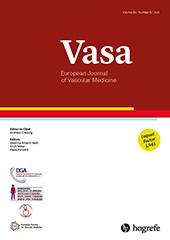Socioeconomic factors and the onset of peripheral artery disease in older adults
Results from a prospective cohort study in a primary care setting (getABI)
Abstract
Summary:Background: As evidence concerning the impact of socioeconomic factors on the risk of peripheral artery disease (PAD) is sparse, we assessed the association of education and area-level factors (population density, type of municipality and local unemployment rate) on the onset of PAD in older adults. Patients and methods: The analysis used data of the getABI study, a prospective cohort study with seven years of follow-up. Onset of PAD was determined by ankle brachial index (<0.9) or PAD symptoms. Cox regression analysis was employed. Results: Out of 5,444 primary care attendees without PAD at baseline, there were 1,381 participants with PAD onset (cumulative observation time 31,739 years), yielding an event rate of 43.5 (0.95 confidence interval [0.95 CI] 41.2–45.8) per 1,000 person-years. Multivariable Cox regression analysis showed an association of PAD onset with low education (hazard ratio 1.29; 0.95 CI 1.14–1.46; P<0.001), high population density (0.93; 0.89–0.98; P=0.002), small cities (compared to large cities) (0.71; 0.53–0.96; P=0.027) and high local unemployment rate (1.04; 1.00–1.07; P=0.032). The impact of low education on PAD onset was higher for men (2.11; 1.64–2.72) than for women (1.22; 1.07–1.40) (interaction term P=0.013). Conclusions: Socioeconomic factors, education as well as area-level socioeconomic indicators, make independent contributions to PAD onset in older adults.
References
1 Neighborhood of residence and incidence of coronary heart disease. N Engl J Med. 2001;345:99–106.
2 . Causal nature of neighborhood deprivation on individual risk of coronary heart disease or ischemic stroke: A prospective national Swedish co-relative control study in men and women. Health Place. 2018;50:1–5.
3 Comparison of global estimates of prevalence and risk factors for peripheral artery disease in 2000 and 2010: a systematic review and analysis. Lancet. 2013;382:1329–40.
4 Prevalence of peripheral arterial disease – results of the Heinz Nixdorf recall study. Eur J Epidemiol. 2006;21:279–85.
5 Mortality and vascular morbidity in older adults with asymptomatic versus symptomatic peripheral artery disease. Circulation. 2009;120:2053–61.
6 . Socioeconomic inequality and peripheral artery disease prevalence in US adults. Circ Cardiovasc Qual Outcomes. 2014;7:532–9.
7 . Socioeconomic status and incidence of hospitalization with lower-extremity peripheral artery disease: atherosclerosis risk in communities study. J Am Heart Assoc. 2017;6(8).
8 . The influence of socio-economic deprivation on rates of major lower limb amputation secondary to peripheral arterial disease. Eur J Vasc Endovasc Surg. 2010;40:76–80.
9 The risk of peripheral artery disease in older adults – seven-year results of the getABI study. VASA. 2016;45:403–10.
10 . Classifying Educational Programmes – Manual for ISCED-97 Implementation in OECD Countries. Paris: OECD Publications Service; 1999. Available from: http://www.oecd.org/edu/skills-beyond-school/1962350.pdf
11 . Prediction of creatinine clearance from serum creatinine. Nephron. 1976;16:31–41.
12 Peripheral arterial disease incidence and associated risk factors in a mediterranean population-based cohort. The REGICOR Study. Eur J Vasc Endovasc Surg. 2016;51:696–705.
13 Incidence of peripheral arterial disease in the ARTPER population cohort after 5 years of follow-up. BMC Cardiovasc Disord. 2016;16:8.
14 . Incidence of and risk factors for asymptomatic peripheral arterial occlusive disease: a longitudinal study. Am J Epidemiol. 2001;153:666–72.
15 2016 AHA/ACC Guideline on the Management of Patients With Lower Extremity Peripheral Artery Disease: Executive Summary: A Report of the American College of Cardiology/American Heart Association Task Force on Clinical Practice Guidelines. J Am Coll Cardiol. 2017;69:1465–508.
16 . Population density, socioeconomic environment and all-cause mortality: a multilevel survival analysis of 2.7 million individuals in Denmark. Health Place. 2012;18:391–9.
17 . Urban population density and mortality in a compact Dutch city: 23-year follow-up of the Dutch GLOBE study. Health Place. 2018;53:79–85.
18 . Does unemployment cause long-term mortality? Selection and causation after the 1992–96 deep Swedish recession. Eur J Public Health. 2016;26:778–83.
19 . Regional differences of standardised mortality rates for ischemic heart diseases in the Slovak Republic for the period 1996–2013 in the context of income inequality. Health Econ Rev. 2016;6:21.
20 A time-series analysis of the relation between unemployment rate and hospital admission for acute myocardial infarction and stroke in Brazil over more than a decade. Int J Cardiol. 2016;224:33–6.
21 . Cardiovascular risk factors differ between rural and urban Sweden: the 2009 Northern Sweden MONICA cohort. BMC Public Health. 2014;14:825.
22 Estimation of ten-year risk of fatal cardiovascular disease in Europe: the SCORE project. Eur Heart J. 2003;24:987–1003.
23 Predicted 10-year risk of cardiovascular mortality in the 40 to 69 year old general population without cardiovascular diseases in Germany. PLoS One. 2018;13(1):e0190441.
24 . Association of peripheral artery disease and chronic limb-threatening ischemia with socioeconomic deprivation in people with diabetes: A population data-linkage and geospatial analysis. Vasc Med. 2021;26(2):147–54.
25 An unequal social distribution of peripheral arterial disease and the possible explanations: results from a population-based study. Vasc Med. 2009;14:289–96.
26 . The English indices of deprivation 2010. London: Department for Communities and Local Government; 2011. Available from: https://assets.publishing.service.gov.uk/government/uploads/system/uploads/attachment_data/file/6320/1870718.pdf
27 Socioeconomic deprivation and the incidence of 12 cardiovascular diseases in 1.9 million women and men: implications for risk prediction and prevention. PLoS One. 2014;9(8):e104671



